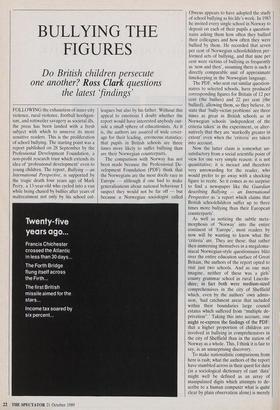BULLYING THE FIGURES
Do British children persecute the latest 'findings'
FOLLOWING the exhaustion of inner-city violence, rural violence, football hooligan- ism, and rottweiler savagery as societal ills, the press has been landed with a fresh subject with which to unnerve its more sensitive readers. This is the proliferation of school bullying. The starting point was a report published on 28 September by the Professional Development Foundation, a non-profit research trust which extends its idea of 'professional development' even to young children. The report, Bullying — an International Perspective, is supported by the tragic death four years ago of Mark Perry, a 13-year-old who cycled into a van while being chased by bullies after years of maltreatment not only by his school col- leagues but also by his father. Without this appeal to emotions I doubt whether the report would have interested anybody out- side a small sphere of educationists. As it is, the authors are assured of wide cover- age for their leading, erroneous statistics: that pupils in British schools are three times more likely to suffer bullying than are their Norwegian counterparts.
The comparison with Norway has not been made because the Professional De- velopment Foundation (PDF) think that the Norwegians are the most docile race in Europe — although if one had to make generalisations about national behaviour I suspect they would not be far off — but because a Norwegian sociologist called
Olweus appears to have adopted the study of school bullying as his life's work. In 1983
he invited every single school in Norway to deposit on each of their pupils a question- naire asking them how often they bullied their colleagues and how often they were bullied by them. He recorded that seven per cent of Norwegian schoolchildren per-
formed acts of bullying, and that nine per cent were victims of bullying as frequently as 'now and then', assuming there is such a directly comparable unit of approximate timekeeping in the Norwegian language.
The PDF, who sent out similar question- naires to selected schools, have produced corresponding figures for Britain of 12 per
cent (the bullies) and 22 per cent (the bullied), allowing them, so they believe, to
state that 'bully-victim problems' are three times as great in British schools as in Norwegian schools 'independent of the criteria taken' in the experiment, or alter- natively that they are 'markedly greater in extent' even when the 'criteria' are taken into account.
Now the latter claim is somewhat un- satisfactory from a social scientific point of view for one very simple reason: it is not quantitative; it is inexact and therefore very unrewarding for the reader, who would prefer to go away with a shocking figure to recite. So it comes as no surprise to find a newspaper like the Guardian describing Bullying — an International Perspective as 'a report which claims that British schoolchildren suffer up to three times more bullying than their European counterparts'.
As well as noticing the subtle meta- morphosis of 'Norway' into the entire continent of 'Europe', most readers by now will be wanting to know what the `criteria' are. They are these: that rather then immersing themselves in a megaloma- niacal Norwegian-style questionnaire blitz over the entire education surface of-Great Britain, the authors of the report opted to visit just two schools. And as one may imagine, neither of these was a girls' county grammar school in rural Lincoln- shire; in fact both were medium-sized comprehensives in the city of Sheffield which, even by the authors' own admis- sion, 'had catchment areas that included within their boundaries large council estates which suffered from "multiple de- privation".' Taking this into account, one might re-express the findings of the PDF: that a higher proportion of children are involved in bullying in comprehensives in the city of Sheffield than in the nation of Norway as a whole. This, I think it is fair to say, is an unsurprising discovery.
To make nationalistic comparisons from here is rash; what the authors of the report have stumbled across in their quest for data (in a sociological dictionary of cant 'data' might well be defined as an array of manipulated digits which attempts to de- scribe to a human computer what is quite clear by plain observation alone) is merely this well-established phenomenon: that both inner cities and large comprehensives are uniquely depressing places which by their very nature promote psychotic be- haviour amongst their inmates.
What strikes one about the study, as opposed to the newspaper reportage of the study, is a distinct lack of profundity. This is further enforced when the definitions of `bullying' and 'violence' used by the PDF are considered. One author suggests 'vio- lence' may take the form of 'name-calling, teasing, sexual taunts, rough treatment of younger boys etc . . .'; another defines `bullying' as 'violence, physical or mental'. Now one does not actually have to enjoy being called by depreciative names to raise objections to this; in every dictionary that I know of 'violence' is quite clearly defined as a physical phenomenon. And yet only 22 per cent are involved in verbal warfare? I begin to wonder whether the children of Sheffield are not actually rather subdued.
Not so the newspapers. An article in the Indy on 5 October was headed 'How the young are bullied — even to death'. This again quotes the one death that appears to have occurred in the modern history of British bullying: that of Mark Perry. it is important to add that he was not actually murdered but that he cycled into the van whilst being chased by his regular tormen- tors. I wonder how many children have lost their lives in friendly horseplay in the meantime.
What is at work is the insidious power of sociology: a research body goes out to ask the people, assumes they are being serious when they provide their answers (I remem- ber very few of my peers treating question- naires as anything other than a joke when I was at school), computes any number of definitive statistics with little regard to the limitations of the data collected, and com- piles a report which, because of the gravity with which the subject is treated, cannot fail to earn respect. I have no doubt that the intentions of the PDF are good, but it is up to the general public to realise that there is more to the statistics thrown to them than meets the eye.



























































 Previous page
Previous page